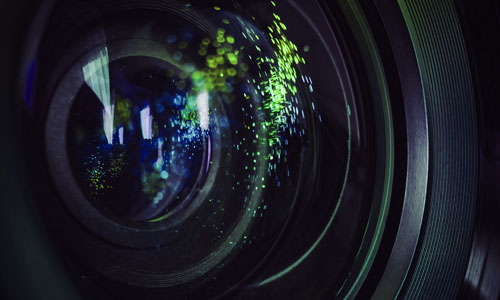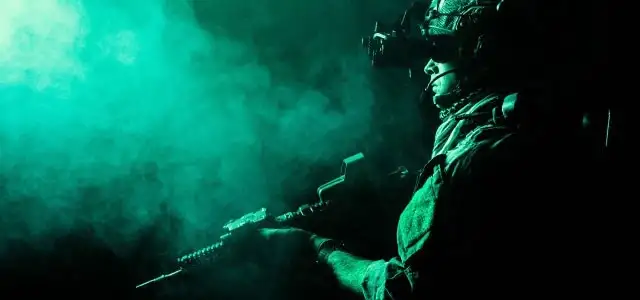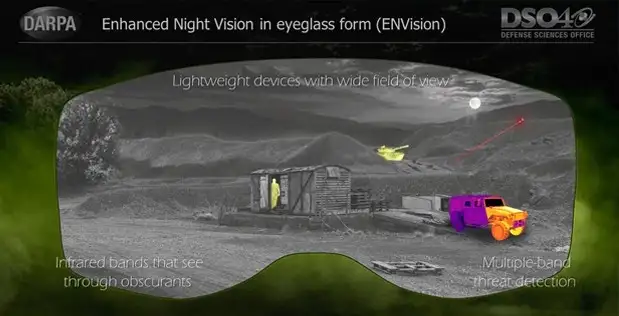
A collaboration between DARPA and SRI seeks to create a pair of night vision glasses so people can see clearly even in the darkest of situations.
“If you’ve never worn night vision goggles for hours at a time, imagine wearing a baseball cap all day with a two-pound weight attached to the front of the bill — that gives you a small sense of the stress experienced.” — Rohith Chandrasekar, program manager in DARPA’s Defense Sciences Office
Imagine being able to put on a pair of glasses that lets you see in the dark like an owl. Night vision is not a natural trait of humans, but it is one that can benefit us in many situations. The natural night vision of the owl and other nocturnal predators took millions of years to evolve. However, a collaboration between DARPA and SRI International seeks to create a pair of night vision glasses that removes the veil of the night so people can see clearly even in the darkest of situations. Known as the AMPED night vision goggles from SRI International, they promise to be a revolution for seeing in the dark.
Making lightweight of night vision
SRI has a prime contract under the DARPA ENVision program to improve upon the usability and power of NVGs (night vision goggles). The project, funded by the DSO (Defense Sciences Office) of DARPA, is to develop night vision from scratch, redesigning the old unwieldy NVGs to create a lightweight pair of glasses with greater usability and advanced night vision power.
In an interview with Dr. David Hill, research scientist at the SRI Applied Physics Laboratory, he explained why NVGs needed this design reboot: “traditional NVG technology is very cool and very useful, but the goggles are bulky, long and very heavy. Wearing a pair of NVGs for any length of time causes neck strain, and they are uncomfortable to wear. In addition, they are limited in wavelength bands and field of view. Using a traditional NVG is a lot like using binoculars, you have a very narrow field of view; you can’t see peripheries.”
These shortcomings acted as kick-starters for a new era of NVGs to turn them into lightweight, wide-angle glasses, rather than goggles. The project is a complete redesign of NVG technology, focusing on the optics and the image intensifier components. Among the design goals are that the night vision glasses must:
- Be lightweight
- Have low torque on the wearer’s neck
- Have a wide field of vision
- Offer minimal distortions
- Capture a wide wavelength band, even into the three-micron range

Conceptual image of night vision glasses
Why SRI for the redesign of night vision?
With a long history of innovation in optics, the institute is well-positioned to work on the redesign of NVGs. In 2019, SRI was awarded a contract under the U.S. Army’s Integrated Visual Augmentation System (IVAS) program to deliver prototypes of a digital night vision camera. The project was based on a low-light-level CMOS image sensor integrated with a custom camera module and optimized for low size, weight, and power (SWAP). This has led to the DomiNite system, a forehead-mounted night vision system that projects its images onto a screen.
Dr. Hill commented on the long history of SRI International and imaging research: “for a number of years, SRI has been looking at low-light infrared imaging and developing advanced detectors. The ENVision project is a confluence of ideas to bring about a new era in night vision goggles.”
Dr. Hill explained that SRI, realizing the current downsides of the technology, has been in discussion about redesigning NVGs for some time, including looking at how to improve detection in the shortwave infrared band. These discussions also encompassed the usability aspects of NVGs and how to reduce bulky lenses using advanced optics. He further discussed the unique combination of expertise and innovation that the institute offers to projects like this:
“SRI can focus on a unique cutting-edge prototype. The goal for ENVision is to do something that hasn’t been done before. SRI often breaks through barriers into what’s technologically possible in sort of all metrics at once.”

ENVision night vision image. Courtesy: DARPA
Projecting the vision: phase one
“We are re-envisioning the way that an image intensifier works; the resulting technology is applicable to any situation in which you want to image infrared light and not just for night vision goggles,” said Dr. Hill.
The first phase is likely to last two years and, in that time, the SRI team expects to develop a monocular: a single eye device that can operate on a benchtop. This prototype would likely not be head-mounted at first but would provide night vision over the full near-IR (infrared) range, from 750 to 1550 nanometers. It would also provide a wider field of view, up to 60 degrees, and dramatically reduce the size and weight of the headset.
Onwards from the initial phase, SRI expects the ENVision system to be useful for any person who needs accessible and powerful night vision. Dr. Hill expects that military uses will be the most obvious candidate for the ENVision glasses and that the technology will improve capabilities for the warfighter in terms of usability, wavelength, field of view and peripheral vision.
In terms of scientific advances, Dr. Hill explained, “we’re trying to advance a number of technologies including in the meta-optic space. The team is on the cutting edge of what’s possible for replacing conventional refractive optics with these very thin, very lightweight, engineered optics based on tiny pillars and tiny shapes on the nanometer scale that provide the same functionality that a big, heavy glass lens offers.”
Projecting the vision: phase two
Phase two will expand the monocle to a full binocular prototype and widen the metrics of what the night vision glasses are capable of. Dr. Hill explained that the project will move past the near IR from 750 to 1550 nanometers, going out to three microns. Also, the team will work to visualize these different ranges separately. “We will project them (images) as different colors within the operator’s field of view. Using color, the wearer will be able to identify whether they’re looking at a near-IR signal or a shortwave IR (SWIR) signal; this capability can be very useful in certain contexts. The goal is to make a very wide field of view as close to a natural field of view as possible so that it feels like wearing a pair of ordinary glasses.”
Multiple challenges ahead
One of the key challenges of the ENVision project is to ensure that the magnitude of the effects needed fits into a very small package. Normally, there are six different lenses in the tubes used in NVGs. This leads to the goggles’ unwieldy weight. Powerful meta-optics are required to provide the corrections and replace these six lenses. The team at SRI will replace all but one of the lenses with thin hundred-nanometer material. Another challenge is the image intensifier. This must be able to capture a very wide wavelength range with very minimal noise at extremely low light levels. On the challenges ahead, Dr. Hill said:
“At SRI, we are trying to bridge the gap between scientific research and something that’s usable. This is the overall mission of SRI. This project encapsulates that mission perfectly. We are taking novel cutting edge advances in science and applying them in a practical and usable way.”
Resources
Press Release, 2019: SRI International Awarded Contract to Support U.S. Army Integrated Visual Augmentation System
DARPA, Night-Vision Revolution: Less Weight, Improved Performance


